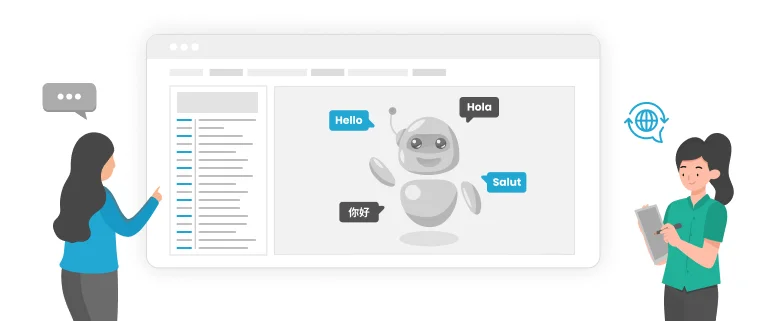This article will help you understand what is gendered language and how it affects our social attitudes.
Does language really shape the way we think?
Well, language tells you a lot about the roles of genders in society and how people perceive men and women in that region. Have you ever noticed that most languages, whether English or Spanish, focus on males, especially if the gender of the subject is not clear, it is automatically referred to as a male?
The question here is, does this make women less important or ignored entities in a social setting?
Today we talk about gender equality, women empowerment, and equal political rights, but do gendered languages, formed over the centuries, in our patriarchal societies push us behind. When it comes to gender equality, we talk about different issues, but languages have rarely been a matter of discussion.
It is high time to understand gendered languages and how they’re impacting social behaviors and attitudes.
Table of Content
What is a Gendered Language?
The gendered language contains words and phrases that are sexist and gender driven. In most cases, gendered languages are male dominant, and they use male as default when the gender of something or someone is not specified.
Where most languages are gendered, there are a few languages that are genderless grammatically or have very few gendered aspects.
In today’s times, where the roles of men and women have changed a lot from what they were a few decades ago.
Gendered languages are becoming a matter of concern with more women in business, and other positions of power in society.
Here Are Some Examples
“Mankind”
Even the languages from more evolved cultures use gendered approaches by using masculine words to represent both genders. For instance, in English, we use mankind or man-made to cover both genders.
‘’Police Women”
When it comes to jobs, we have used languages in a way to define gender roles. For example, you’re more likely to say or hear policemen than policewomen. You already feel awkward saying the feminine version of the same job occupation.
Similarly, “firemen” is a common word, unlike “firewomen”, so somewhere we have been conditioned to believe that certain occupations are male dominant.
“Working Mother”
We use the word “working mother” quite often now, referring to women who have kids and do jobs or businesses. But, why don’t we use the term “working dad”, because it is obvious that men are supposed to work in offices, whether or not they have kids?
“Female Leaders”
“Lean In” is a famous book about leadership, or to be more clear, female leadership. The author of the book, Sheryl Sandberg, stated “In the future, there will be no female leaders. There will just be leaders.”
It seems like the author has somewhere realized the sexist attitudes of society, regardless of what she has achieved in life so far.
“Mistress”
It is a female equivalent of a master, but not many ladies would like to be entitled to mistress because of the negative connotation attached to the word. We say, master of a craft, would you say, “mistress of a craft” for a woman?
Well, you better not, because it is not any way closer to being a master. Dictionary might tell you that mistress is a female companion of a man. But, in a social definition, the word is used for a woman having a sexual relationship with a married man.
Significance & Impact
The above examples very well define such languages, and how these are being quite unfair towards females in many ways. No matter how much we talk about women’s rights and equality, if our basic communication approaches are gendered, we’ll never be able to fill that gender gap.
Language not just influences the way we communicate but is a source of cultural manifestation. Some cultures have more male-dominating language, and it somehow says a lot about their conservativeness and overall viewpoint about genders.
Pronouns
AAP vs TUM
In the Urdu language, spoken in Pakistan, wives are supposed to call their husbands “aap”, which is a formal way of addressing someone; whereas, husbands usually call their wives “tum”, which is an informal way of addressing someone. The translation for both “aap’’ and “tum” is “you” in English.
The above example tells you a lot about the nature of the husband-wife relationship in the country. Where the husband is considered a more important and dominating figure in a relationship.
You are Gender Neutral
In the above example, we can see that, unlike many other languages where they use different pronouns to address a second person (men and women), English uses “you” which is more gender neutral. The pronoun doesn’t refer to any gender, which makes it more gender-inclusive.
However, English is not all gender-inclusive either. You would find many examples in this language that are quite gendered.
In English, there are some ways you can avoid gendered pronouns and keep your sentences gender neutral.
Use Plural Pronouns and Nouns
So, this is an amazing trick to avoid using he, she, his, and her. In the English language, it has been a common practice to use masculine pronouns as default. However, it has become quite outdated in the western world.
To make the meaning clear, you have to place both feminine and masculine pronouns with the example where the gender is not specified. Or, the easiest way is to use plural pronouns that would help you keep your sentences gender neutral.
For an author, reading is essential to improve his/her writing skills.
For authors, reading is essential to improve their writing skills.
In the above example, “his/her” is replaced with “their” by changing the pronoun to plural. This is the best way indeed to avoid gender-exclusive language, whenever it is possible.
Use the Singular Pronoun “They”
The other way to avoid using the language of gender is by using “they” instead of “he” or “she”. “they” is a pronoun that refers to both male and female in a third person.
However, there are some who refuse to use “they” in English writing, for this is a less formal way of speech, while others appreciate the use of “they” to be gender neutral.
McDonald’s has a diversified menu globally; they keep their brand localized to fit the needs of local customers.
Using “they” in your English speech would make you gender neutral, and it is indeed the most respectful way of addressing all genders, even the things without genders.
Social Issues Created by Gender Dominant Languages
Today we talk about feminism and gender equality. The role of women in society has changed a lot from what it was a few decades back. Now, females don’t have to fight for their right of voting.
Thankfully, we’ve way passed that mentality that has treated women as second-class citizens. We’ve become slightly evolved when it comes to gender equality and political rights of women, but still, a lot of work needs to be done, especially on the language side.
Some languages, may not intentionally, still represent males as powerful and authoritative figures and women as weak and oppressed groups. Sexism exists in our societies, and gender-biased languages somehow guard the old-school patriarchal ideologies.
It is time that we must do something about these languages, and do our bit to raise awareness and resist following language norms that are biased towards one gender only.
Gender Neutral Terms, Why Does This Matter?
According to the research conducted in 2019, it is estimated that gender-neutral languages are not just progressive but also improve a positive attitude towards all genders.
It reduces gender biases, and this small shift can change social behaviors to a huge extent. When it comes to brand localization, it is important to consider gender-neutral languages.
One crucial thing to notice here is that some languages are more gendered than others. For instance, in the Spanish language, male and female distinctions are way higher than in the English language, which can make the translation even more complicated.
So, while translating the content from Spanish to English, translators have to keep in mind the gendered terminologies, with other linguistic and cultural aspects of the content.
This is going to have a huge impact on your brand reputation globally, and your customers are likely to see you as a progressive brand.
Why Understanding Gendered Language Important in Localization?
Modern societies are becoming more sensitive towards such languages, and just like all other facets of life, inclusivity is much needed in languages. In the business world, the concern about gender-inclusive languages has become even higher. Be it the role of female leaders in businesses or women in the workforce, gendered language have a huge impact on behaviors and perceptions about women.
It is not just about doing business, but you have to make sure that your brand is equally appealing to both genders (if it is not gender-specific). Similarly, when it comes to localization, the translators must be careful about gender-biased language in the content.
Especially, if you are taking your product to first-world or developing countries, where the population is much more sensitive about gender equality, you must localize the gendered terminologies to gender-neutral languages. Using gendered languages could be offensive in some cultures, and it will affect your brand reputation.
Final Verdict
Not many people have ever noticed the gendered nature of the languages they speak. It is important for languages to become gender neutral because how we communicate says a lot about what we believe. There are many gender-neutral options out there that can help you communicate your message profoundly using gender-inclusive language. Especially, if you’re a translator providing localization services, it is even more important for you to consider the gendered approaches in languages and make them neutral to all genders while translating. This way your content will cause no offense to any gender that would make your brand resonate with all customers.







